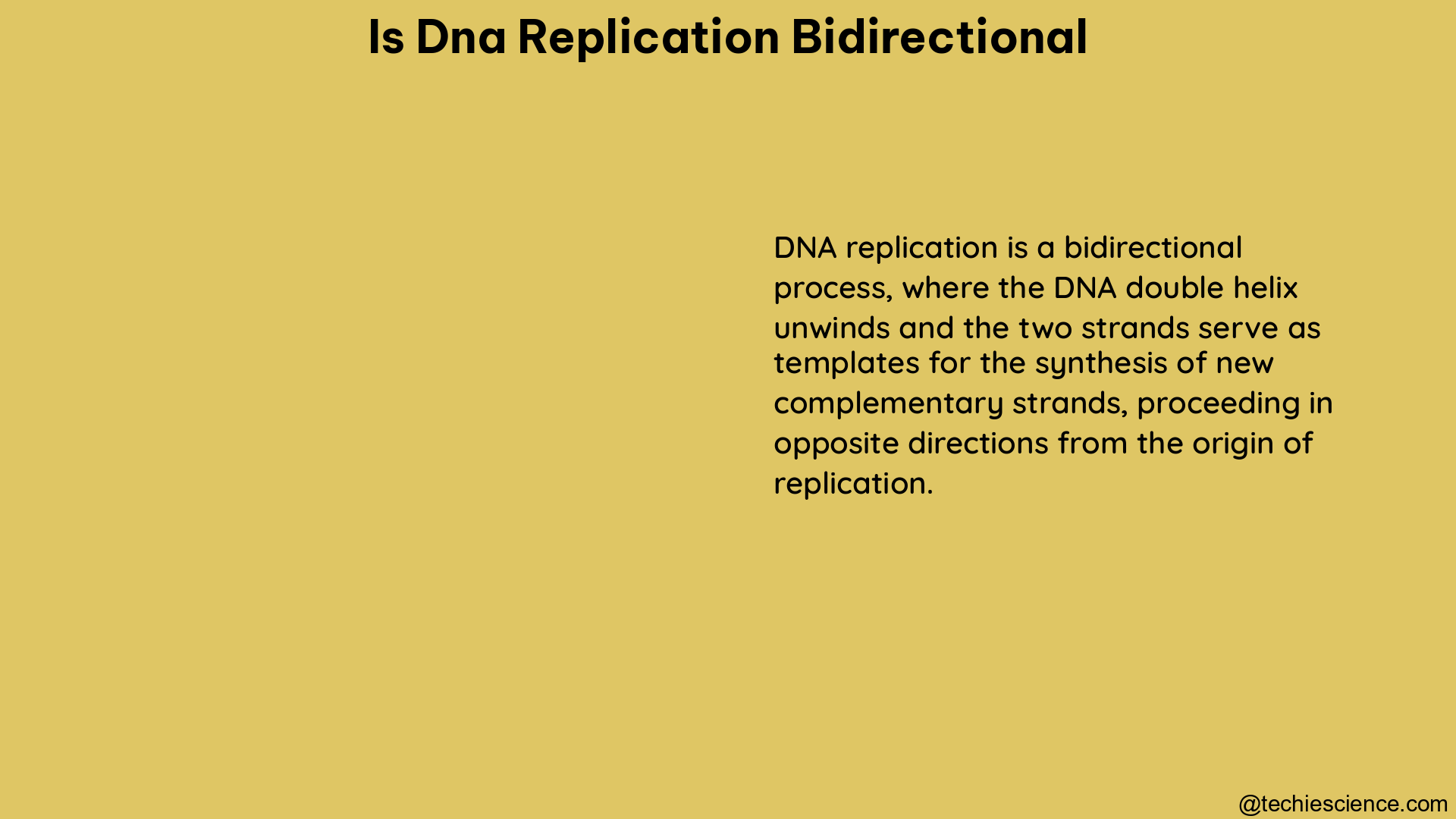Summary
DNA replication is a fundamental biological process that occurs in a bidirectional manner. This means that the replication of DNA starts at a specific site called the replication origin and simultaneously moves outward in both directions. This bidirectionality of DNA replication has been observed and extensively studied in various organisms, including bacteria and eukaryotes. Understanding the mechanisms and dynamics of this process is crucial for gaining insights into the cellular mechanisms of DNA replication and its implications in various biological processes.
Understanding Bidirectional DNA Replication in Bacteria

In bacteria, such as Escherichia coli, DNA replication is initiated at a single origin of replication, known as the oriC (origin of chromosome replication) site. From this origin, the replication fork moves in two directions, with each fork progressing until it reaches the terminus region of the circular bacterial chromosome.
The Meselson-Stahl experiment, a landmark study in molecular biology, provided evidence for the semi-conservative nature of DNA replication and also supported the bidirectional nature of this process in bacteria. In this experiment, E. coli cells were grown in a medium containing heavy isotopes of nitrogen (15N), which were incorporated into the DNA. When these cells were transferred to a medium containing the lighter isotope (14N), the DNA strands were observed to separate into two daughter strands, each containing one heavy and one light strand, demonstrating the semi-conservative nature of DNA replication.
Furthermore, the Meselson-Stahl experiment showed that the replication of the bacterial chromosome occurs in a bidirectional manner, with the replication forks moving away from the origin in opposite directions until they meet at the terminus region.
Bidirectional DNA Replication in Eukaryotes
In eukaryotic cells, the process of DNA replication is more complex compared to bacteria due to the presence of multiple origins of replication on each chromosome. Unlike the single origin in bacteria, eukaryotic chromosomes have numerous origins of replication, which are distributed along the length of the chromosomes.
At each origin of replication, the DNA unwinds and the replication process begins, leading to the formation of multiple replication bubbles or forks that move in both directions from the origin. This bidirectional replication continues until the replication forks from adjacent origins meet and the replication process is completed.
The timing and efficiency of DNA replication in eukaryotes are tightly regulated, with early-replicating regions of the genome associated with open chromatin, higher gene density, and increased gene expression levels. Conversely, late-replicating regions tend to be heterochromatic and show higher rates of genomic instability.
Measuring DNA Replication Dynamics and Bidirectionality
Researchers have developed various genomic methods to quantify and analyze the dynamics of DNA replication, including its bidirectional nature. These methods provide valuable insights into the mechanisms and cellular consequences of DNA replication timing.
-
Detection of Single-Stranded DNA: By probing replicating DNA for the presence of single-stranded DNA, researchers can map the locations and dynamics of replication forks, revealing the bidirectional nature of DNA replication.
-
Immunoprecipitation of Nucleotide Analogues: Cells can be labeled with nucleotide analogues, such as bromodeoxyuridine (BrdU) or 5-ethynyl-2′-deoxyuridine (EdU), which are incorporated into newly synthesized DNA. Immunoprecipitation of these labeled DNA fragments can provide information about the timing and efficiency of DNA replication, including its bidirectionality.
-
Detection of Okazaki Fragments: Okazaki fragments are short, discontinuous DNA fragments synthesized on the lagging strand during DNA replication. By detecting and analyzing these fragments, researchers can gain insights into the dynamics of DNA replication, including its bidirectional nature.
-
Nucleotide Analogue Incorporation and DNA Copy Number Analysis: Quantifying the incorporation of nucleotide analogues and analyzing DNA copy number can help reconstruct the genomic replication timing profiles of various species and cell types, providing valuable information about the bidirectionality of DNA replication.
These genomic methods, combined with advanced bioinformatics and computational tools, have enabled researchers to obtain detailed, quantifiable data on the dynamics of DNA replication, including its bidirectional nature, across different organisms and cell types.
Implications of Bidirectional DNA Replication
The bidirectional nature of DNA replication has several important implications:
-
Efficient Replication: The simultaneous replication of DNA in both directions from the origin allows for a more efficient and rapid replication of the entire genome, ensuring the timely duplication of genetic material during cell division.
-
Maintenance of Genome Integrity: The bidirectional replication process helps to maintain the integrity of the genome by reducing the risk of replication errors and ensuring the accurate duplication of genetic information.
-
Regulation of Gene Expression: The timing and efficiency of DNA replication, which are influenced by the bidirectional nature of the process, can have significant impacts on gene expression patterns and cellular function.
-
Implications in Disease and Therapeutic Targeting: Understanding the mechanisms and dynamics of bidirectional DNA replication can provide insights into the development and progression of various diseases, such as cancer, and may inform the development of targeted therapies.
In conclusion, the bidirectional nature of DNA replication is a fundamental characteristic of this essential biological process, observed in both prokaryotic and eukaryotic organisms. The development of advanced genomic methods has enabled researchers to obtain detailed, quantifiable data on the dynamics of DNA replication, including its bidirectionality, providing valuable insights into the mechanisms and cellular consequences of this process.
References:
- Quizlet – Chapter 25 Flashcards
- Quizlet – Genetics Chapter 11 Flashcards
- BYJU’S – Why is DNA replication bidirectional?
- Quizlet – DNA_Replication Flashcards
- Genomic methods for measuring DNA replication dynamics – PMC
I am Ankita Chattopadhyay from Kharagpur. I have completed my B. Tech in Biotechnology from Amity University Kolkata. I am a Subject Matter Expert in Biotechnology. I have been keen in writing articles and also interested in Literature with having my writing published in a Biotech website and a book respectively. Along with these, I am also a Hodophile, a Cinephile and a foodie.